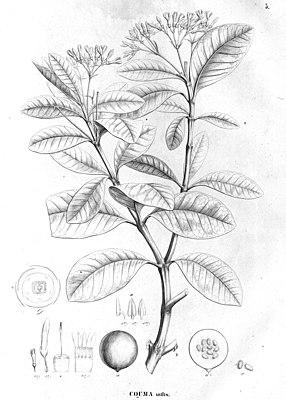Couma utilis
| Couma utilis | ||||||||||||
|---|---|---|---|---|---|---|---|---|---|---|---|---|

Couma utilis |
||||||||||||
| Systematics | ||||||||||||
|
||||||||||||
| Scientific name | ||||||||||||
| Couma utilis | ||||||||||||
| ( Mart. ) Müll.Arg. |
Couma utilis is a species of plant in the dog poison family from the subfamily Rauvolfioideae from northern Brazil , Colombia and Venezuela .
description
Couma utilis grows as a mostly semi-evergreen tree up to 15-20 meters high, or less often as a small shrub. The trunk diameter reaches 60–80 centimeters. The brown, thick bark is relatively smooth. The tree has a milky sap .
The simple, short-stalked, slightly leathery and bare leaves are opposite or whorled, in groups of three to four. The short petiole is up to 1 centimeter long. The entire, elliptical to obovate, rounded to rounded or pointed leaves are 6–12 inches long and 3–6 inches wide. The leaf base is wedge-shaped and sloping. The stipules are missing.
Axillary, zymose , double- dolded and long-stemmed inflorescences are formed. In the cone and the umbellules are bracts formed. The white-pink or violet and five-fold, stalked and hermaphrodite flowers have a double flower envelope . The calyx is small and five-lobed. The crown is fused in the shape of a salver plate with expansive, elongated to oblanceolate, up to 8 millimeter long tips. There are 5 almost sessile stamens , with arrow-shaped anthers, in the upper, 8 millimeter long, narrow and greenish corolla tube. The unilocular ovary is half upper constant, with a relatively short stylus with a small stylus head (Clavuncula) having two scars branches .
Roundish to 3–4.5 centimeters in size, green and brownish when ripe, soft, multi-seeded, leathery, bald berries (armored berries ) are formed on long stems. The many, 4–6 millimeters large, elliptical to ovate seeds in the yellowish-brownish, creamy pulp are soft and flat.
Taxonomy
The first description of Basionyms Collophora utilis was made in 1830 by Carl Friedrich Philipp von Martius in Buchn. Rep. Pharm. 35: 186. The division into the genus Couma took place in 1860 by Johannes Müller Argoviensis in CFP von Martius & auct. suc. (eds.), Fl. Bras. 6 (1): 19. Further synonyms are Couma dulcis Spruce ex Müll.Arg. and Couma multinervis Monach.
use
The fruits are edible, they are known as Sorva or Sorvinha . The fruits are usually harvested when they are still green and unripe, then they are still firm.
The sweet milky juice is used as chewing gum or as a milk substitute as well as in drinks or for sealing boats and canoes. It is also used medicinally.
The poorly durable, relatively light wood is used for some applications.
literature
- Jules Janick, Robert E. Paull: The Encyclopedia of Fruit and Nuts. CABI, 2008, ISBN 978-0-85199-638-7 , p. 72 f.
- Food and fruit-bearing forest species. 3: Examples from Latin America , FAO Forestry Paper 44/3, FAO, 1986, ISBN 92-5-102372-7 , p. 109 ff.
- Harri Lorenzi: Árvores Brasileiras. Vol. 2, Instituto Plantarum, 1998, ISBN 85-86714-07-0 , p. 26, online at StuDocu.
- Joachim W. Kadereit , Volker Bittrich: The Families and Genera of Vascular Plants. Vol.XV : Flowering Plants Eudicots , Springer, 2018, ISBN 978-3-319-93605-5 , pp. 242, 261, 266.
Web links
- Couma utilis at Useful Tropical Plants.